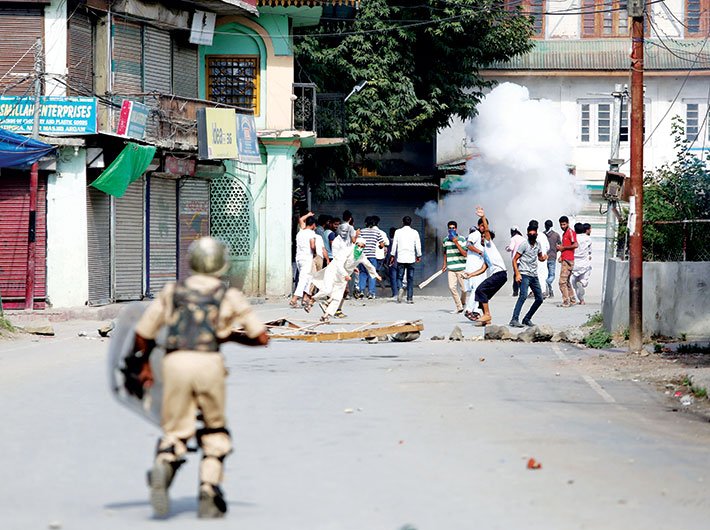The grave implications of the record-breaking low turnout (about seven percent) for one byelection and postponement of another
Kanni jang’, or the fighting with stones, is an expression in Kashmiri language for a street clash between two rival camps. These fights would see a lot of bile flowing around and stones being hurled by members of rival groups at each other. For the onlookers – who would gather in no time – it was somewhat innocuous game and entertainment as everyone knew the stones are not meant to hurt anyone. The ‘jang’ was more of a show of strength and pouring of anger than a violent clash. Stone throwers of Kashmir made their presence felt in the newspaper headlines for years when the entire Valley was seething with anger and grief at the arrest of popular Kashmiri leader Sheikh Mohammad Abdullah in 1953. The Sheikh was removed as the prime minister and imprisoned by Delhi on suspicion of hobnobbing with Pakistan.
At the end of the decade of the eighties, Kalashnikovs had arrived in Kashmir; ‘kanni jang’ became passé and a faint memory. Everyone thought that this was end of the bluster of an angry Kashmiri stone-thrower, whose weapon was meant to convey his anger and not shed blood.
But that was not to remain so for long. On April 9, marauding mobs of young Kashmiris were hurling stones at security forces guarding the polling stations across Srinagar where the Sheikh’s son Farooq Abdullah, a three-time chief minister and former central minister, was contesting for Lok Sabha. The stone-bearing boys were well organised. Defying formidable security they besieged the polling stations, some barged inside and damaged the electronic voting machines (EVMs). In Budgam, the forces had to open fire to keep them at bay. Eight young men were killed.
It was the bloodiest of election in Kashmir. No wonder at 7.14 percent the voter turnout was the lowest ever.
Now what happened next was to see the stone-throwing Kashmiri return to the centre stage of the 25-year-long turmoil in the Valley. “The leader of the stone-throwing group in a village or a mohalla will now become the hero and role model for the younger boys,” says a former insurgent, who laid down the arms long back. Like him, many in the security establishment are upset at the ‘abject surrender of authority’ by the state before the stone-throwers.
They feel the decision of the election commission to defer the elections for Anantnag by-polls fearing violence has given legitimacy to the stone-pelters.
“The situation in Kashmir would only worsen now,” says a Kashmir-based academician wishing not to be named. This phrase has often been heard in Kashmir at all the turning points in the insurgency. He feels the phenomenon of stone-pelting mobs has helped end the stigma of terrorism on the anti-India protests in Kashmir. “Now, India is morally on weaker ground; its forces are seen killing boys who just have stones in their hands.” He however rues the return of ‘kani jang’ has blurred the line between terror and protests and also ushered in anarchy in the society.
However, an MLA from south Kashmir told Governance Now that the stone-throwing is not a simple and innocuous strategy it is made out to be. “There is massive [Islamic] radicalisation of the youth on the ground and also through social media. These groups work under a well-knit strategy and use WhatsApp and other social media platforms to desseminate plans for protests.” He says it would be a mistake to not treat this as part of Pakistan’s ever-evolving gameplan to take on India in its only Muslim-majority state.
Where do the boys get the stones from as Kashmir does not have a rocky soil? It seems the youth collect the arsenal and keep it at a secret place, away from the prying eyes of their elders, for use. “Stones are even purchased and distributed discreetly by the over-ground supporters of separatists,” a police officer said.
Ashima Kaul, a Delhi-based peacemaker, who had worked with the first batch of stone-hurling youth of Kashmir following the 2008 protests, however, has a different viewpoint. Kaul’s NGO Yakjah had organised workshops to help these men. “To me they came across like any other young persons who were trying to vent their anger, feeling disconnected with the system and also their inner self.” She worked with them through theatre and other media and ended up making them express themselves without resorting to extreme ways. Yakjah had opened a counseling centre for the youth at Sopore which closed down because of the lack of funds.
Stone-pelting mobs had brought Kashmir to a virtual standstill for five summer months last year. Of late they are throwing stones at the security forces to disrupt their targeted raids at terrorist hideouts in rural Kashmir. At many places the stones have hit the men while the terrorists had managed to flee well in time to escape a sure death. The army has told the Mehbooba Mufti government that controlling mobs is not its job. After police drawing flak for using pellet guns against stone-pelting mobs which blinded scores, its grappling with the idea of a deterrent yet non-lethal way to deal with the situation. “The stone-throwers are working on the directions of terrorists; at times we have even spotted an odd gun-wielding terrorist amidst them,” says a senior police officer from Kashmir.
However, Mehbooba’s opponents blame her for entering into an unholy alliance with the BJP and adding to the confusion of the young people. They say that before the assembly election, the PDP was seen as a major anti-BJP (read Hindutva) force and since they are together now it’s difficult for the youth to make sense of it and hence the uprising.
On the other hand, leaders of all parties wonder why the Narendra Modi government is refusing to extend an olive branch to the disgruntled Kashmiris as the centre’s indifference is causing frustration and anger. The constant refrain in the Valley is that while so many people have sacrificed their lives in 25 years, hamein kuch to milna chahiye tha (we should have got something in return from Delhi.).
“The stone-throwing youth are overwhelmed with a sense of hopelessness,” says a ruling party legislator. “They can’t have jobs in Kashmir; going outside the state for the jobs and education is a scary proposition, given the incidents of beating and bullying of Kashmiri students at many places – it’s a kind of vicious cycle that an average youth finds himself in today.”
Another reason for the youth unrest is the rise of ‘Hindu radicalisation’ across India as the stray incidents of intolerance projected on television screens instill fear in the minds of Muslims in Kashmir. “This is pushing them to the lap of Islamic radicals and making them vent their anger on anything symbolising India,” says a legislator.
aasha@governancenow.com
(The article appears in the April 16-30, 2017 issue of Governance Now)

